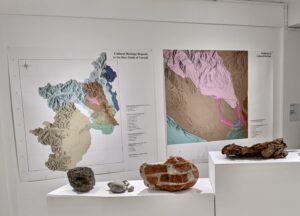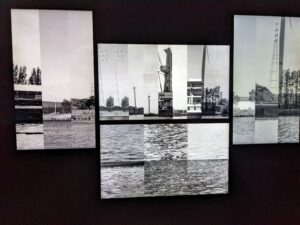Faces of Water
A short introduction to the exhibition Faces of Water by its curator Sofie Crabbé. The exhibition takes place until Sunday, December 4, in Bozar, Brussels. It shows the results of residencies in Italy and Belgium of the following artists-researchers: Joshua G. Stein, Theresa Schubert, Anna Ridler and Haseeb Ahmed. Each of them portrays water and its intertwining with our contemporary culture, combining social, artistic, and scientific interests.

Theresa Schubert, Glacier Trilogy PART 2 Conservation of earth memory (2022). Photo: L. Pil
There would be no life on earth without water. Without seas and oceans, there would be no living organisms. Water is essential for food, clothing and technology production, and indispensable for transport and energy. Through abundance or scarcity, it can also have a destructive side. Concern for water is more relevant than ever.
Globally, we face unprecedented water challenges. The ocean may change more in the next 100 years than it has in the past 50 million years. Glaciers are melting faster than ever, sea levels are rising dramatically and pollutants are flowing into our streams from industry. The importance of water often goes no further than its utilitarian value, but what about humanistic, moral, emotional, aesthetic and ethical values? How do artists deal with these immense challenges? And what would happen if artists built bridges to all branches of society that can bring about change, such as industry, research and citizens? What if they worked together to find innovative ways to raise our awareness of the importance of water and water challenges, and to rethink the urgency of our relationship to water?

Joshua G. Stein / Radical Craft, Sediment as Cultural Heritage (2022). Photo: L. Pil
The exhibition Faces of Water presents artworks by artist-researchers Joshua G. Stein, Theresa Schubert, Anna Ridler and Haseeb Ahmed. The creations came about during four STARTS4Water residencies in northern Italy and Belgium in 2021-2022. The residencies combined artistic, scientific and technological research to expand and adjust people’s mindset around water. The artworks shed critical light on our position as human beings, and our use/misuse of water, in the past and in the present. How can we use water more sustainably in the future?
The STARTS4Water residencies are part of the European Commission’s S+T+ARTS Programme (DG CONNECT). S+T+ARTS (Science, Technology and the Arts) encourages interdisciplinary collaborations between artists and scientists, researchers, engineers and companies to support innovation in industry and society. To paraphrase the writer Vladimir Nabokov, there is no art without facts and no science without imagination. Ten residencies took place across the European continent, each focusing on a region-specific water challenge. Local experts provided intensive support and feedback to the artists.
Theresa Schubert focuses on the importance of glaciers and the resulting rivers and streams as indicators of climate change, while Joshua G. Stein explores the relationship of humans to these waterways, studying natural and anthropogenic sediments found there. Anna Ridler examines the interaction between water (systems) and the financial market, starting from the challenge of “water capitalism” as a possible solution for better management and understanding the true value of water. Finally, Haseeb Ahmed attempts to answer the complex issue of pharmaceutical pollution in various water cycles.

Anna Ridler, The landscape of finance (2022). Photo: L. Pil
Looking to the past, the Faces of Water exhibition questions the present and points to the future. The artworks dwell on the mystery that is time. ‘Panta rhei’ (‘everything flows’), the Greek philosopher Heraclitus is said to have said. “No man ever steps in the same river twice, for it’s not the same river and he’s not the same man.” Everything is in a continuous state of change. And yet, as several works in this exhibition show, we attempt to hold or accelerate the flow of time using digital technologies such as AI, 3D printing and data visualisation.
Sofie Crabbé
***
The works in the exhibition are the result of residencies organised by LUCA School of Arts, GLUON, Cittadellarte – Fondazione Pistoletto and UNIDEE Residency Programs, with the support of their local ecosystem of partners.